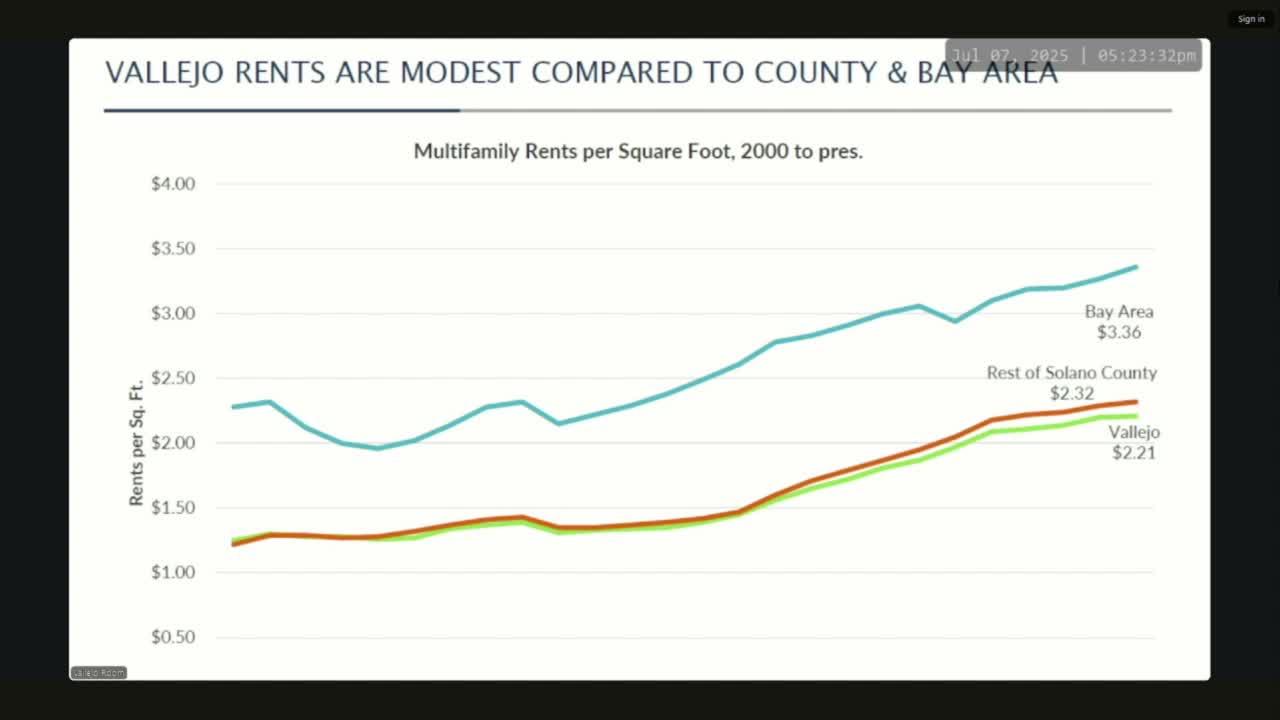Vallejo Assesses Inclusionary Housing Ordinance Amid Rising Costs and Low Permitting Rates
July 07, 2025 | Vallejo, Solano County, California
This article was created by AI summarizing key points discussed. AI makes mistakes, so for full details and context, please refer to the video of the full meeting. Please report any errors so we can fix them. Report an error »

In the heart of Vallejo's city hall, a pivotal discussion unfolded during the Joint City Council and Planning Commission special meeting on July 7, 2025. As city officials and planning experts gathered, the focus turned to the pressing issue of housing development and the challenges that have shaped Vallejo's real estate landscape over the past two decades.
The meeting began with a stark overview of the housing market's fluctuations, revealing a significant decline in construction permits since the early 2000s. At the peak, Solano County saw around 2,000 single-family units permitted annually, with Vallejo contributing approximately 400 to 500 units each year. However, the housing market crash of 2007 drastically altered this trajectory, leading to a steep decline in construction that persisted for years. By the late 2010s, while the county began to recover, Vallejo's permitting numbers remained stagnant, highlighting a troubling trend for the city.
As the discussion progressed, the conversation shifted to the feasibility of new housing policies. Experts noted that rising construction costs have outpaced rent increases, complicating the financial viability of new projects. With construction costs climbing due to labor and materials, coupled with higher mortgage interest rates, developers face increasing hurdles. The current interest rates hover around 7%, a stark contrast to the historically low rates of the previous decade, further straining the market.
The meeting also addressed Vallejo's position in comparison to other cities regarding inclusionary housing policies. While many cities in the Bay Area require 10 to 15% of new developments to be affordable, Vallejo currently lacks such a policy, making it a potential leader in this area if action is taken. The analysis revealed that Vallejo's overall fee burden for new construction is lower than that of neighboring cities, yet developers still express concerns about the cumulative impact of various fees imposed by different agencies.
As the meeting drew to a close, questions arose about the pipeline of permitted units versus actual construction. Many projects remain stalled, caught in a web of financing challenges and rising costs. This situation reflects a broader trend across the Bay Area, where developers are hesitant to move forward without assurances that their investments will yield profitable returns.
The discussions at this special meeting underscored the complexities of Vallejo's housing market and the urgent need for strategic policies to stimulate development. As city officials contemplate the future, the path forward remains uncertain, yet the potential for change looms large on the horizon. The decisions made in the coming months could reshape Vallejo's landscape, offering hope for a more vibrant and accessible housing market.
The meeting began with a stark overview of the housing market's fluctuations, revealing a significant decline in construction permits since the early 2000s. At the peak, Solano County saw around 2,000 single-family units permitted annually, with Vallejo contributing approximately 400 to 500 units each year. However, the housing market crash of 2007 drastically altered this trajectory, leading to a steep decline in construction that persisted for years. By the late 2010s, while the county began to recover, Vallejo's permitting numbers remained stagnant, highlighting a troubling trend for the city.
As the discussion progressed, the conversation shifted to the feasibility of new housing policies. Experts noted that rising construction costs have outpaced rent increases, complicating the financial viability of new projects. With construction costs climbing due to labor and materials, coupled with higher mortgage interest rates, developers face increasing hurdles. The current interest rates hover around 7%, a stark contrast to the historically low rates of the previous decade, further straining the market.
The meeting also addressed Vallejo's position in comparison to other cities regarding inclusionary housing policies. While many cities in the Bay Area require 10 to 15% of new developments to be affordable, Vallejo currently lacks such a policy, making it a potential leader in this area if action is taken. The analysis revealed that Vallejo's overall fee burden for new construction is lower than that of neighboring cities, yet developers still express concerns about the cumulative impact of various fees imposed by different agencies.
As the meeting drew to a close, questions arose about the pipeline of permitted units versus actual construction. Many projects remain stalled, caught in a web of financing challenges and rising costs. This situation reflects a broader trend across the Bay Area, where developers are hesitant to move forward without assurances that their investments will yield profitable returns.
The discussions at this special meeting underscored the complexities of Vallejo's housing market and the urgent need for strategic policies to stimulate development. As city officials contemplate the future, the path forward remains uncertain, yet the potential for change looms large on the horizon. The decisions made in the coming months could reshape Vallejo's landscape, offering hope for a more vibrant and accessible housing market.
View full meeting
This article is based on a recent meeting—watch the full video and explore the complete transcript for deeper insights into the discussion.
View full meeting
